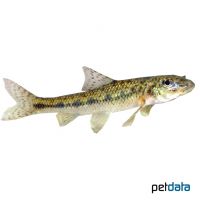Gudgeon (Gobio gobio)
| Gudgeon Gobio gobio | |
|---|---|
| Name | Gudgeon |
| Name Lat. | Gobio gobio |
| Family | Gudgeons |
| Family lat. | Gobionidae |
| Order | Carps |
| Order lat. | Cypriniformes |
| Origin | Europe |
| Habitat | Streams, rivers |
| Diet | Omnivore |
| pH | 6.5-7.5 |
| Behavior | Peaceful |
| Keeping | Group |
| Care Level | Easy |
| Reproduction | Egg scatterer |
| Breeding | Moderately difficult |
| Life Span | 5-8 years |
| Protection | No |
| Metric Units | |
| Size | 10-15 cm |
| Temperature | 4-25 °C |
| Hardness | 10-20 °dH |
| Aquarium | ~ 200 l or ponds |
| US Units | |
| Size | 4"-6" |
| Temperature | 39-77 °F |
| Hardness | 178-356 ppm |
| Aquarium | ~ 50 gal or ponds |
Distribution and habitat
Gudgeons are widespread in Europe and are absent only in the extreme north and south. They live mostly in calm sections of flowing waters, such as streams and rivers, and near the shores of clear, large lakes, as well as in the brackish water zone of the Baltic Sea. These typical demersal fish stay in schools over sandy-gravelly bottoms.
Maintenance
The pond should be furnished with pond, floating and underwater plants (oxygenators) and a substrate of sand and round-grained gravel suitable for burrowing
When maintaining a cold-water aquarium, care should be taken to provide a large swimming area in addition to dense perimeter planting and numerous hiding places (roots, rocks). A soft substrate, oxygen-rich water and slightly shaded light (floating plants) is ideal. No ammonia, ammonium and nitrite should be detectable in the water, and the nitrate value should not exceed 100 mg/l. To ensure the water quality and oxygen content should not be missing a filter adapted to the water volume.
Diet
They are omnivores that feed on small bottom animals and detritus. The diet consists of live or frozen cyclops, daphnia, mysis, artemia, mosquito larvae, etc., supplemented with a high-quality sinking dry food (granules, pellets), but this should not be the main component of the diet. In addition, they also need some vegetable food, such as soft plant material (algae leaves), scalded spinach or dry food with high vegetable content (e.g. kelp, spirulina). Only feed as much as will be eaten in a few minutes. A regular and varied diet promotes health and increases resistance.
Behaviour and compatibility
They are lively and sociable fish that do not exhibit any aggressive or incompatible behaviors. At least 5, but preferably much more gudgeons should be kept together. Socialization with other peaceful pond fish is well possible
In principle, only mutually compatible fish species with similar demands on water quality and water temperature may be socialized.
Reproduction and breeding
Males acquire a dot-shaped, white spawning rash at spawning time and are slightly more slender than females.
Females spawn in shallow water between May and June, at a water temperature of 12-18°C. The bluish-white, sticky eggs are laid on rocks and plants. The larvae hatch after 10-30 days. The young fish are sexually mature after 2-3 years. Life expectancy can be up to 8 years.
Important
Gudgeons make squeaking sounds that are thought to be used for intraspecies communication.
If they are overwintered in the pond, sufficient depth and oxygen supply (filter, oxygen dispenser, ice free holder) must be ensured
At temperatures below 8-10 °C the metabolism of the fish slows down and they do not accept food anymore, accordingly feeding must be stopped. If the temperature drops further, they will hibernate buried in the mud. In spring, with rising temperatures, feeding can slowly be resumed. Feeding may also be necessary during prolonged warm periods in winter.
The well-being of the fish should be monitored regularly. A regular partial water change, according to the pond size is recommended, even if the pollutant load has not yet reached the upper limit. Sudden changes in water quality should be avoided. Newly introduced fish must be accustomed slowly to the water in the pond or aquarium
Further literature can be found in your pet store.
References
Text: Werner Winter; Image: petdata
Source: BMELV (1998): Tierschutzgutachten - Haltung von Zierfischen (Süßwasser); RIEHL & BAENSCH (2006): Aquarien Atlas Bd. 1, Mergus Verlag; ENGELMANN (2005): Zootierhaltung - Tiere in menschlicher Obhut: Fische; Harri Deutsch Verlag
- Gemäß § 21 Abs. 5 Tierschutzgesetz idgF
